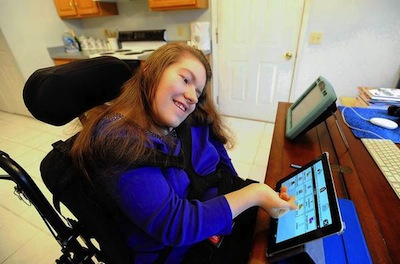What you Need to Know about Assistive Technology
For people without disabilities, technology makes things easier. For people with disabilities, technology makes things possible–International Business Machines (IBM) 1991 training manual
Most of us use technology on a daily basis. Perhaps you use a cell phone calendar to remember your schedule. You might use Google maps to direct you to where you’re going, or you might adapt your e-reader with an increased font to make the text easier. If you use one of these, you use technology to make your life easier. For students with learning disabilities, whether cognitive or physical, assistive technology aims to enhance and improve educational opportunities with the use of the latest technology. They do this by bypassing, working around, or compensating for a child’s specific learning disabilities. In speech-therapy, assisstive technology is used to provide access to communication tools that help a child read, write, express or comprehend language.
http://youtu.be/xMHuWGUEu2M
Know the Law:
According to the Individuals with Disabilities Act (IDEA), school districts must consider assistive technology for any child in special education. AT must be considered for children with disabilities if it is needed to receive a “free and appropriate public education.” Therefore, all parents should be aware of the many resources that are available to students. They can benefit children of any age – from toddler years where a child is reading Brown Bear to the college years of writing a thesis – it’s important to know that AT can never start too early or late.
What Does AT Include?
Assisstive technology can be “low-tech” (a very simple tool, such as a thicker pencil or pointer), or “high-tech” (like a sophisticated computer). Supports can be for: math, language arts like writing or reading, organization, listening or memory. You might have noticed a student with a voice amplifier, large print reading materials, or controls that let them manage their environment from their wheelchair (such as turning on the TV)- these are all Assisstive Technologies.
The following list from Schwab Learning highlights some possible AT tools and solutions:
Reading
- OCR/Speech Synthesis
- Speech Synthesis
- Alternative format books (e.g., tape, CD)
Writing
- Word Processor
- Word Prediction
- Speech Synthesis
- Speech Recognition
- Graphic Organizer
- Spell Checker
- Abbreviation Expansion
- Alternative Keyboard
Math
- Talking Calculator
- Electronic Worksheets
Memory
- Personal Data Manager
- Tape Recorder
- Free-form Database
Organization
- Personal Data Manager
- Tape Recorder
- Free-form Database
Listening
- Assistive Listening Device
- Tape Recorders
Speech Pathologists are primarily concerned with Augmentative and Alternative Communication (AAC)– this is electronic and non-electronic devices that help persons with speech and/or hearing disabilities communicate. Examples are picture communication systems, computers with voice output, modified typewriters, head pointers, text to voice software.
AT and the iPad
With the advent of and introduction of the iPad into classrooms, assistive technology has become more accessible to parents and students- and has also received much more attention. Students can use this tool to improve note taking, create and modify flashcards, replay or record lessons (with video, audio and/or images), share documents and access adapted books and curriculum supports. Apps are constantly being updated and new ones are frequently created- making this a fast paced piece of technology that can sometimes be hard to keep up with!
Getting Your Child an AT Evaluation
If you think your child might benefit from Assistive Technology, the first step is an evaluation by a specialist. A formal AT assessment is provided by someone who is recognized as an AT specialist with knowledge and training in all of the above technologies. They might be a specialist in another area (speech and language, physical therapy) but also have received certification in AT. These specialists often work in private practice or for school districts. Ask your school district to provide an evaluation. You could also look here for a certified AT specialist, or consult Easter Seals in your area.




